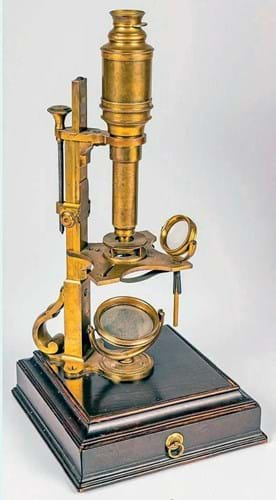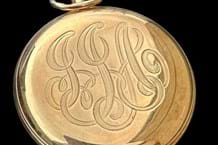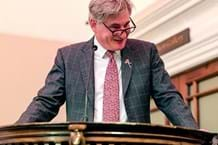
Version of Powell & Lealand’s famous ‘No 1’ compound monocular and binocular microscope, dated 1898, estimate £3000-5000 at Flints.
At Flints’ scientific instruments sale in Thatcham, Berkshire, on May 1 it has a guide of £3000-5000.
Hugh Powell first went into partnership with his brother-in-law Peter Lealand in 1841, the pair producing a series of microscopes from workshops near Euston Square in London that culminated with the definitive version of the No 1 in 1869. With only minor additions, it was made almost unchanged for 40 years.
Belgian Henri Van Heurck (1839-1909) wrote glowingly of the firm in his book The Microscope its Construction and Management in 1892: “Messrs Powell & Lealand occupy quite a unique position in the microscopic world. Their workshops are small, the number of instruments which they produce are few, but every piece of apparatus, marked with their name, is an artistic production, perfect in all its details.
“Moreover, both instruments and objectives of these makers are in the greatest request and are used in England by all serious microscopists.”
Out of Ohio
A collection of microscopes and other antique scientific instruments from the estate of Ohio scientist John A Davidson Jr (1939-2023) comes for sale at Gray’s Auctioneers in Cleveland, US, on April 17.
Titled The Art of Discovery, Part 1, proceeds from the sale will benefit the Dittrick Museum of Medical History at Case Western Reserve University where many of the pieces had been on display.
Davidson Jr, who worked with the tyre maker BF Goodrich and later at Case Western Reserve, had a great passion for historical instruments and machines. His collection of 18th and 19th century microscopes numbers more than 40 different models.
Made c.1745 is a compound microscope signed for John Cuff (c.1708-72). An important London instrument maker, he traded as a ‘Spectacle and Microscope Maker’ at ‘the sign of the Reflecting Microscope and Spectacles opposite Sergeant’s Inn’ on Fleet Street from 1737-57 and then from ‘the sign of the Double Microscope, three Pairs of Golden Spectacles & Hadley’s Quadrant’ opposite Salisbury Court in the Strand.
Famously, after supplying several microscopes to the court for George III, he was painted in his workshop by the Anglo-Swiss painter Johann Zoffany in 1772.
Cuff’s instrument, employing ‘new’ features such as a Lieberkuhn reflector to enhance the amount of focused light, is estimated at $3000-5000.
From the Victorian ‘brass and glass’ era of instrument production is a James Smith compound monocular first-class microscope, c.1840, estimated at $3000-5000. Signed J. Smith London, with the serial number 12, makes this one of the earliest-known British achromatic compound microscopes known. The earliest microscope by Smith owned by the Royal Microscopical Society has the serial number 43.















